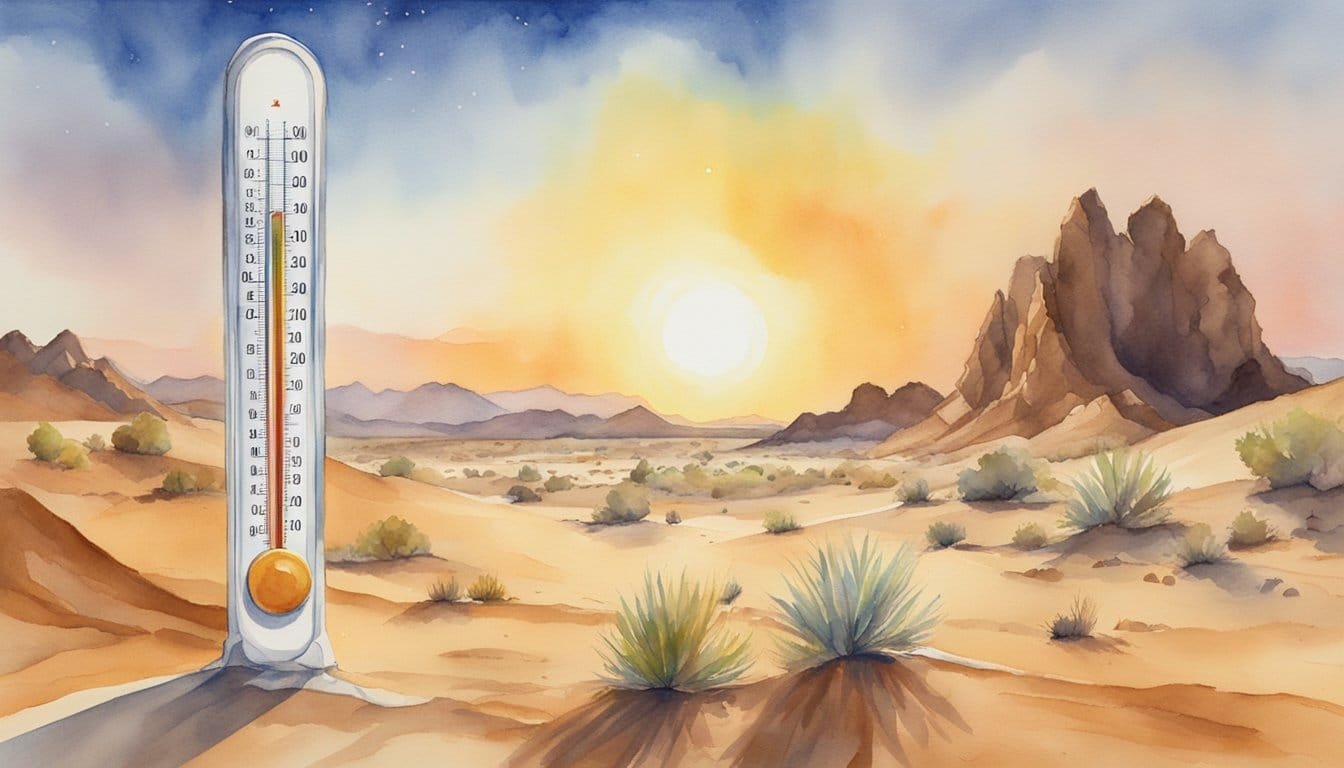Overview of the Hottest Places on Earth
The planet Earth hosts some truly scorching spots, where temperatures soar to extremes. These locations challenge life and offer a unique glimpse into Earth’s diverse climatic conditions.
Defining Extreme Heat
When referring to the hottest place on earth, people often think of Death Valley, an infamous desert valley in California, known for its blistering heat. Here, specifically at Furnace Creek, temperatures have been recorded that push the boundaries of the mercury. For example, a staggering 134°F (56.7°C) was reported in 1913, cementing Death Valley’s fiery reputation.
On the other side of the world, the Lut Desert in Iran competes fiercely for the title. The World Meteorological Organization (WMO) acknowledged this area for having the highest recorded surface temperatures on the planet, thanks to satellite readings of land skin temperatures that have consistently confirmed extreme heat conditions.
It’s important to distinguish between air temperature and surface temperature. While air temperature is typically measured a few feet above the ground, surface temperature refers to how hot the ground itself gets under the sun. These high temperatures in the Lut Desert are so intense that the land itself seems to be almost aflame from space, with measurements sometimes exceeding 159°F (70°C).
Understanding these places helps scientists and meteorologists gauge the impact of global warming and predict how rising temperatures might affect different regions of the world. Whether it’s the dry, scorching basin of Death Valley, or the sunbaked sands of the Lut Desert, these hot spots remain the earth’s natural ovens, sizzling under the sun’s relentless gaze.
Geographical Location and Climate Conditions

When scouting for the titleholder of Earth’s hottest place, researchers examine both temperature records and average conditions to determine the areas most consistently scorching under the sun.
Contributing Climatic Factors
An array of elements contributes to extreme heat in several locations around the globe. Death Valley, California, typically recognized for its blistering temperatures, owes much of its heat to below-sea-level basin topography, resulting in high air temperatures and low humidity. Meanwhile, the Danakil Depression in Africa, and specifically Dallol within it, experiences intense geothermal heating that amplifies the already torrid climate.
The Flaming Mountains in China are not only symbolically named; their bare, erosion-sculpted red sandstone beds absorb sunlight efficiently, converting it almost unforgivingly into heat. In Kebili, Tunisia, hot and dry desert air contributes to high temperatures, similar to conditions found in certain parts of Iran, Libya, Iraq, and Oman, where the sun blazes nearly year-round, especially in the arid expanses of terrain.
Varied Temperature Records
Navigating through the numbers to pinpoint peak heat encounters some diversity. Death Valley boasts an official record of 134°F, but questions about the veracity of older measurements bring modern weather stations into sharper focus. It’s not uncommon for Death Valley‘s Furnace Creek station to register temperatures above 120°F during summer months in the Northern Hemisphere.
Iran sees its own extremes, with the Lut Desert often not far behind in the rankings. While Tunisia‘s Kebili and the Flaming Mountains don’t consistently achieve such staggering highs, their peak recordings still impress, or perhaps appall, those who prefer cooler climates. Whether in the Northern Hemisphere or the Southern Hemisphere, the key factors of relentless sun exposure and minimal cloud cover virtually ensure that these regions maintain their reputations as Earth’s top contenders for the heat crown.
Record-Breaking Measurements

In the quest to identify the hottest places on Earth, two factors are crucial: historical data and modern technological capabilities. From ancient readings to state-of-the-art satellite insights, these measurements give us a fascinating glimpse into our planet’s extremes.
Historical Temperature Records
Historically, Kebili in Tunisia has been recognized for reaching one of Earth’s highest temperatures. However, the small town of Dallol in Ethiopia competes fiercely, with its infamous geothermal area where heat flows visibly from the ground, resembling an alien landscape. While the highest recorded shade temperature is 54.4°C (129.9°F), disputed claims exist of higher readings, such as the 56.7°C (134°F) recorded in 1913 in Death Valley, California, which is often challenged due to inconsistencies in the historical measurement process.
China’s Flaming Mountains have been mythologized as a fiery inferno, and while actual temperature records may not match the legends, they certainly reflect intense summer heat. Historical records there rely on conventional thermometers, which can be affected by numerous factors, making accurate comparisons over time quite complex.
Modern Observations and Technology
With the aid of modern technology, our understanding of Earth’s high temperatures has become more precise. NASA plays a critical role in this area, using satellites to measure Land Surface Temperatures (LST), which can be hotter than air temperatures measured by thermometers. These satellite instruments capture infrared radiation emitted by the surface of the Earth to calculate heat emissions and LST with remarkable accuracy.
In some of the hottest parts, such as the Lut Desert in Iran or the aforementioned Dallol, satellites have clocked surface temperatures exceeding expectations. These are not air temperatures, but they are significant for understanding how heat flows affect the overall climate and how extreme conditions can get at the surface where people might walk or land cover changes.
Local Ecosystems and Human Impact

In some of Earth’s hottest locales, both natural ecosystems and human activity coexist, shaped by the extreme heat. Discover how species adapt to sizzling conditions and the ways in which human presence reshapes these harsh landscapes.
Adaptations to Extreme Heat
Extreme environments such as Death Valley National Park and the Lut Desert in Iran are home to highly specialized flora and fauna. These organisms exhibit remarkable adaptations like nocturnal lifestyles, heat-resistant enzymes, and physical features that reflect sunlight or dissipate heat. The landscape itself, often sparsely vegetated and bone-dry, hinges on the rare event of rains to catalyze bursts of life. Science continues to unravel these biological mysteries, with recent news highlighting how some extremophiles in these areas not only survive but thrive.
Tourism and Habitation
Places like Death Valley or Mitribah, Kuwait, attract visitors with their record-breaking temperatures. Tourism can lead to habitation changes in these desert valleys, where the Mojave Desert’s rugged beauty meets human infrastructure. While local economies benefit, the impact on the ecosystems can be significant. In areas like Turbat, Pakistan, and Athens, Greece, the influence of tech like air conditioning contributes to the urban heat island effect, further altering the local climate. Despite the harsh conditions, these areas remain important he delivers reminders of the resilience of life and the complexities of human impact on the environment.
Global Heat Phenomena and Trends

The Earth’s temperature is a tapestry woven by various weather patterns and impacted by human activities. Recent trends show a remarkable upswing in heat extremes across the globe, with certain regions becoming particularly notorious for their scorching temperatures.
Weather Patterns Affecting Temperature
Heatwaves stand as one of the most direct manifestations of heightened global temperatures. These prolonged periods of excessive heat are often exacerbated by specific atmospheric conditions. For instance, changes in circulation patterns in the atmosphere, influenced by the presence of mountain ranges or the lack thereof, can trap hot air in regions. This can result in extreme heat events, as seen in the United States or Europe. Mali and other parts of Africa are also subjected to blistering heat partially due to such geographical and meteorological setups. Greece and Israel, flanking the Mediterranean, frequently experience similar phenomena, where warm air lingers and temperatures soar.
Implications of Rising Temperatures
The implications of rising temperatures are far-reaching and can be seen across continents. In Europe, increasing temperatures have brought about a surge in heat-related illnesses and have put stress on ecosystems not adapted to such conditions. Similarly, in Asia, particularly in densely populated cities, the climbing mercury often leads to substantial public health concerns and decreased work productivity. Africa, with countries like Mali, contends with drought and reduced agricultural output. It is not just the land; the atmosphere itself is changing, with implications for the severity and duration of heatwaves around the globe. Scientists studying trends in heat stress suggest that without mitigation efforts, many regions, including parts of Europe and the United States, could see even more dramatic temperature increases in the years to come.

